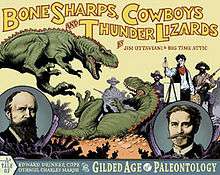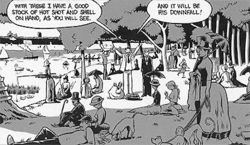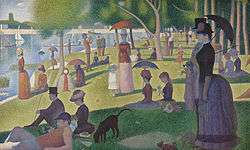Bone Sharps, Cowboys, and Thunder Lizards
Bone Sharps, Cowboys, and Thunder Lizards: A Tale of Edward Drinker Cope, Othniel Charles Marsh, and the Gilded Age of Paleontology is a 2005 graphic novel written by Jim Ottaviani and illustrated by the company Big Time Attic. The book tells a fictionalized account of the Bone Wars, a period of intense excavation, speculation, and rivalry which led to a greater understanding of dinosaurs and other prehistoric life in the western United States during the late 19th century. Bone Sharps follows the two scientists Edward Drinker Cope and Othniel Marsh as they engage in an intense competition for prestige and discoveries. Along the way, the scientists interact with historical figures of the Gilded Age, including P. T. Barnum and Ulysses S. Grant.
 Cover of Bone Sharps, Cowboys, and Thunder Lizards | |
| Author | Jim Ottaviani |
|---|---|
| Illustrator | Big Time Attic |
| Country | United States |
| Language | English |
| Publisher | G.T. Labs |
Publication date | October 2005 |
| Media type | Print Paperback |
| Pages | 165 pp |
| ISBN | 978-0-9660106-6-4 |
| OCLC | 62186178 |
| LC Class | QE707.C63 O88 2005 |
Ottaviani grew interested in the time period after reading a book about the Bone Wars. Finding Cope and Marsh unlikeable and the historical account dry, he decided to fictionalize events to service a better story. Ottaviani placed the artist Charles R. Knight into the story as a relatable character for audiences. The novel was the first work of historical fiction Ottaviani had written; previously he had taken no creative license with the characters depicted. Upon release, the novel received praise from critics for its exceptional historical content, although some reviewers wished more fiction had been woven into the story.
Plot summary
The novel begins with Othniel Charles Marsh on a steam train between New York City and New Haven, where he first meets the showman Phineas T. Barnum. Barnum shows Marsh a copy of the Cardiff Giant; Marsh informs him he intends to expose the giant as a fake. In Philadelphia, Henry Fairfield Osborn introduces artist Charles R. Knight to Edward Drinker Cope, a paleontologist whose entire house is filled with bones and specimens. Cope is commissioning a painting, something to "catch the spirit" of the sea creature Elasmosaurus. Cope leaves for the West as the official scientist for the U.S. Geological Survey (USGS). On the way, he meets Othniel Charles Marsh, a fellow paleontologist, and shows him his dig site at a marl pit in New Jersey; after Cope leaves, Marsh talks to the owner of the land and pays him off to gain exclusive digging rights. At Fort Bridger, Wyoming, Cope meets Sam Smith, a helper to the USGS. During excavations, Cope finds some of the richest bone veins ever. Sending back carloads of dinosaur bones east by train, Cope encounters Marsh, who is heading out west as well. Marsh travels in style, lounging in coach while the rest of his team travels third class. At Fort McPherson, Nebraska, Marsh meets "Buffalo" Bill Cody, who serves as their guide, along with a Native American Indian tribe. Marsh discovers many new fossils, and promises to Chief Red Cloud that he will talk to the President of the United States about the situation of the Native Americans—they have been given spoiled food in exchange for their land. Back East, Knight has finished his reconstruction of Elasmosaurus. He and Knight return to the marl pits of New Jersey, but are forced away. Cope becomes furious and storms away when he learns Marsh has bought the digging rights and published a paper revealing his reconstruction of Elasmosaurus is flawed.
Some time later, bone hunter John Bell Hatcher has taken to gambling, as his employer Marsh is not providing him with enough funds. Marsh lobbies the Bureau of Indian Affairs on behalf of Red Cloud, but also visits with the Geological Survey, insinuating that he would be a better leader of the USGS than Cope. After learning about Sam Smith's attempted sabotage of Cope and once again receiving no payment from Marsh, Hatcher leaves his employ. Marsh, now representing the survey, heads west with wealthy businessmen, scoffing at the financial misfortunes of Cope, whose investments have failed.


Cope travels with Knight to Europe; Knight with the intention of visiting Parisian zoos, Cope with the intent of selling off much of his bone collection. Cope has also spent much of his money buying The American Naturalist, a paper in which he plans to attack Marsh's dealings. Hatcher arrives in New York to talk about the find Laelaps; in his speech, he subtly hints at the folly of Marsh's elitism and backstabbing, as well as Cope's collecting obsession. While attending a conference, Marsh learns that his USGS expense tab (to which he had been charging drinks) has been withdrawn, his publication has been suspended, and the fossils he found as part of the USGS are to be returned to the Survey. His colleagues now shun him, the Bone War feud having alienated them. He is forced to go to Barnum to try to obtain a loan.
Osborn and Knight arrive at Cope's residence to find the paleontologist has died of illness. The funeral is markedly pitiful, with only a few Quakers and the two friends in attendance. Cope has bequeathed his remains to science, and requested to have his bones considered for the Homo sapiens lectotype. Back at Marsh's residence, the visiting Chief Red Cloud examines Marsh's luxuries. Red Cloud's interest is piqued by a long tusk from a mastodon. Marsh relates an ancient Shawnee legend that once there were giant men proportionate to the mastodons before they died out. Chief Red Cloud remarks that it is a true story; Marsh rebukes him, saying that science tells modern man that his ancestors were smaller, not larger, than him. Red Cloud, on his way out, responds, "It is not a story about science. It is about men."[1]
Years later Knight and his wife are taking their granddaughter Rhoda to the American Museum of Natural History. Knight, well known to the staff, is visiting the closed-off areas to have a look at the new mammoth specimens: the girl, however, is eager to see more of her grandfather's paintings. Meanwhile, the staff are finally getting around to sorting out Marsh's long-neglected collection of fossils. Two of the workers discover Knight's Leaping Laelaps has been accidentally left in the storeroom yesterday. The painting is taken back downstairs while the workmen unknowingly leave Cope's and Marsh's bones behind.
Development

Jim Ottaviani conceived of Bone Sharps while working at the University of Michigan Library in Ann Arbor. Ottaviani's job included purchasing books for engineering topics, but a new book about the Bone Wars caught his eye. He bought the book himself and found himself fascinated by the rivalry between Cope and Marsh.[3][4] He described his process as spending time doing research, before turning an outline and timeline into a structured story.[5] Using the book as a starting point, Ottaviani read the accounts and biographies of Cope and Marsh as well as other period sources. During the course of his research Ottaviani found the then-unpublished autobiography of Charles Knight, which inspired him to make the book into a work of historical fiction. Ottaviani had previously written non-fiction books and comics on scientific figures, but had never written a work of historical fiction. "I found the whole 'war' aspect over-hyped," Ottaviani recalled. "These guys never came to blows, or even did anything that went very far beyond questionable ethics."[4] In comparison to his previous works, Ottaviani called the scientists "the bad guys".[6]
While the majority of Bone Sharps is true and all of it is based on history, Ottaviani took liberties throughout to better serve the story.[4] In real life, Knight did not meet Cope until only a few years before Cope's death; In addition, Knight's autobiography states that it was reporter William Hosea Ballou who introduced the two, not Osborn.[4][7] There is also no evidence Marsh and Knight ever met. On Knight's role in the story, Ottaviani wrote:
As I was reading about Cope and Marsh, I ran across Knight as something of a bit player in their lives. As I got further into the Cope and Marsh story, and I liked the two less and less as people—which is different from liking them as characters, of course—I wanted to have a character in the book for the readers to root for, and neither of the scientists could fill that role. When I found out that Knight had met Cope just before Cope died, I became convinced that he was the character I needed.[8]
Ottaviani's interest in Knight eventually led to his company G.T. Labs publishing Knight's autobiography, with notes by Ottaviani and forewords by Ray Bradbury and Ray Harryhausen.[8] Other character relationships were fictionalized as well: editor James Gordon Bennet, Jr. never lobbied with Cope, and never exposed Marsh's will. Cope's bones also never made it to New York.[9] Some conversations, due to their private nature, were fictionalized; Ottaviani makes up Marsh's lobby to Congress and what happened during his meeting with President Grant, and P.T. Barnum never told off Marsh the way he did in the novel.[10] Ottaviani also wove the story Marsh tells about the Mastodon from several different versions of the legend.[11] A key plot point is fabricated for the purposes of dramatic irony: in the book, Marsh has his agent Sam Smith leave a Camarasaurus skull for Cope to find and mistakenly put on the wrong dinosaur. Instead, Hatcher finds it; Smith tries to keep an unwitting Marsh from getting it, but due to Marsh's obnoxious manner he lets him after all. As a result, Marsh mistakenly classifies the (non-existent) Brontosaurus. Ottaviani admits in the book he invented this, as "the literary tradition of hoisting someone up by his own petard was too good to pass up".[12]
While Ottaviani was putting his ideas together, he met Zander Cannon at the 2004 San Diego Comic Convention. Cannon and associates were forming a new production studio, "Big Time Attic"; Ottaviani mentioned he had a proposal he wanted to show them. Referring to Big Time Attic, Ottaviani stated in an interview that "A newly formed studio taking on a 160-page graphic novel is ambitious" and that he was lucky to have had the book published.[3] Even the format—the book is wider than it is tall—was a departure for Ottaviani. He explained that since the story was talking about "wide expanses of territory" and the American West, the artists at Big Time Attic wanted a more non-traditional landscape page design.[3]
Reception
The book was generally well-received upon release. Comic book letterer Todd Klein recommended the book to his readers, stating that the novel was able to convey the depths of Cope and Marsh's rivalry and "we can only wonder how much more could have been accomplished if [Cope and Marsh] had only been willing to team up instead".[13] Klein's complaints focused on the somewhat stiff art and the difficulty in telling some characters apart, but said these shortcomings did not affect the flow and reading.[13] Johanna Carlson of Comics Worth Reading found Bone Sharps's central message, "the question of whether promotion is a necessary evil (to gather funds through attention) or a base desire of those with the wrong motivations", still relevant to today's society; Carlson also lauded the flow of the novel and some of the intricate details in the story and setting.[14] Other reviewers praised Ottaviani's inclusion of notable historical figures,[8] and the educational yet entertaining feel of the work,[15] and expressive artwork.[16]
In addition to minor issues with the art, Entertainment Weekly's Tom Russo felt that more fiction could have been used in the mostly non-fiction writing.[17] Due to the historical background of the book, Bone Sharps has been used in schools, as part of a study testing the effects of using comic books to educate young children.[18] Since the release of the graphic novel, Ottaviani has published other slightly fictionalized historical stories, including Levitation: Physics and Psychology in the Service of Deception and Wire Mothers: Harry Harlow and the Science of Love.[19]
References
- Ottaviani, 141.
- Ottaviani, 129.
- Wolk, Douglass (October 11, 2005). "Dinosaurs and Cowboys". Publishers Weekly. Archived from the original on February 9, 2009. Retrieved February 4, 2008.
- Spurgeon, Tom (June 12, 2005). "A Short Interview With Jim Ottaviani". ComicsReporter.com. Archived from the original on July 19, 2015. Retrieved January 1, 2007.
- Rode, Mike (September 30, 2011). "Meet a Visiting Cartoonist: A Chat with Jim Ottaviani". Washington City Paper. Retrieved October 29, 2018.
- Fox, Carol (October 1, 2005). "Cowboys, Dinosaurs, Heisenberg and Bohr". SequentialArt.com. Archived from the original on December 11, 2015. Retrieved February 2, 2008.
- Knight, Charles R (2005) Charles R. Knight: Autobiography of an Artist. Ann Arbor, MI: G.T. Labs.
- Mondor, Colleen (January 1, 2006). "Comic Books and Thunder Lizards". BookSlut.com. Archived from the original on April 22, 2015. Retrieved January 20, 2008.
- Wallace, David R (1999). The Bonehunters' Revenge. New York: Houghton Mifflin.
- Jaffe, Mark (2000). The Gilded Dinosaur: The Fossil War between Cope and Marsh and the Rise of American Science. New York: Crown Publishers. 90.
- Adams, Richard C (1997). Legends of the Delaware Indians. Syracuse, New York: Syracuse University Press. pg 57–58.
- Ottaviani, 9–10.
- Klein, Todd (August 15, 2007). "And Then I Read: Bone Sharps, Cowboys And Thunder Lizards". KleinLetters.com. Archived from the original on September 21, 2015. Retrieved February 2, 2008.
- Carlson, Johanna (March 25, 2006). "Bone Sharps, Cowboys, and Thunder Lizards". ComicsWorthReading.com. Archived from the original on April 2, 2014. Retrieved February 2, 2008.
- Agamemnon, Bob (May 8, 2005). "Sunday Slugfest: Previews". Comics Bulletin. Archived from the original on February 8, 2009. Retrieved February 1, 2008.
- Staff. "Fiction Book Review: Bone Sharps, Cowboys, and Thunder Lizards". Publishers Weekly. Retrieved October 29, 2018.
- Russo, Tom (October 14, 2005). "Book Review: Bone Sharps, Cowboys, and Thunder Lizards". Entertainment Weekly. Archived from the original on February 12, 2010. Retrieved February 2, 2008.
- Hughes, Sarah (April 5, 2005). "Comic Book Science in the Classroom". National Public Radio. Archived from the original on March 15, 2011. Retrieved February 1, 2008.
- Jordan, Justin (2007). "Science of the Unscientific with Jim Ottaviani | CBR". www.cbr.com. Retrieved 3 November 2018.
External links
- Bone Sharps, Cowboys, and Thunder Lizards Preview at G.T. Labs